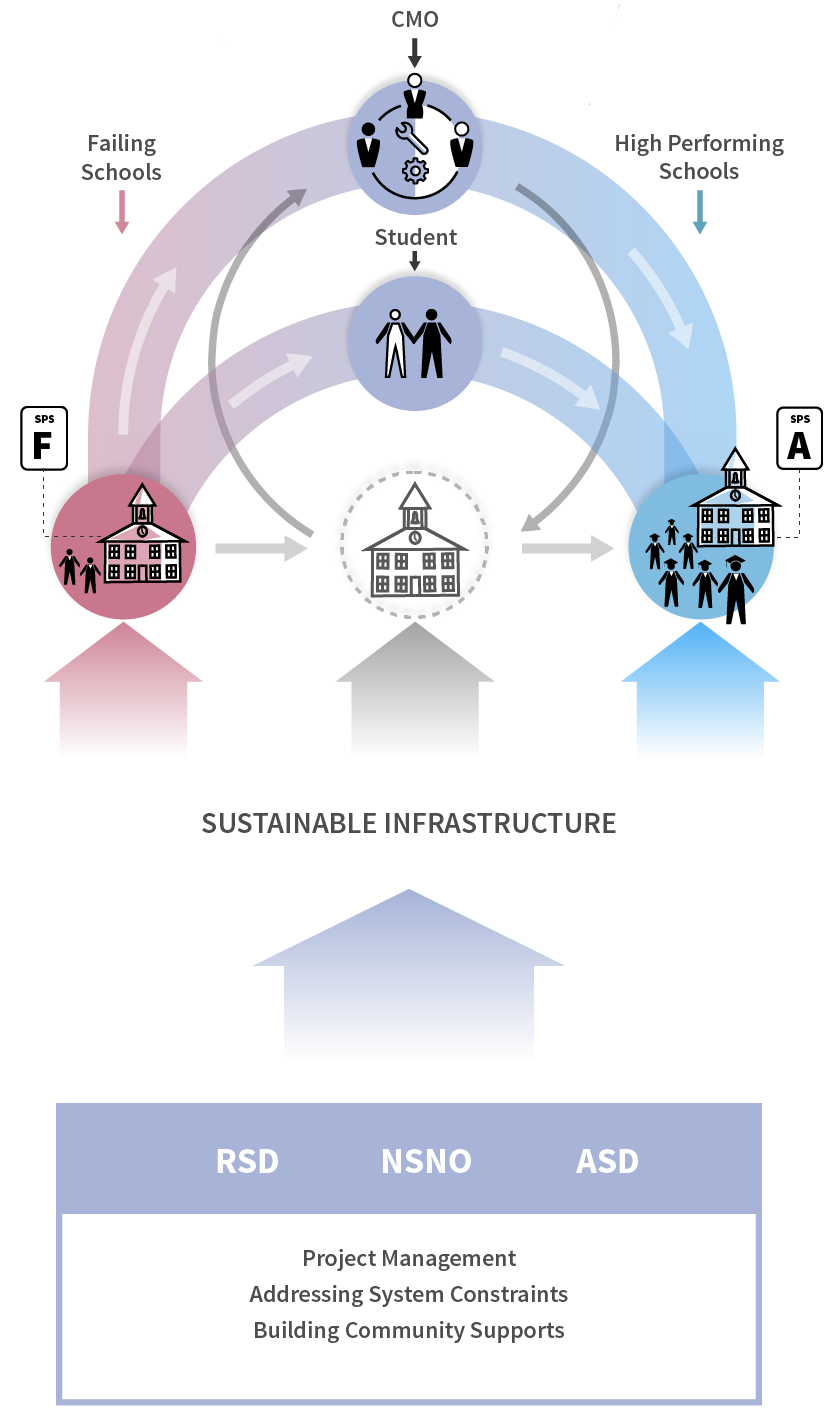
Our Research Questions
The Charter Restart Model Theory of Action posits that school quality will improve by turning failing schools over to operators with demonstrated capacity to run high performing schools:
THEORY OF ACTION

As such, most CMOs that received CRM funds designated a Flagship school, i.e. an existing school operated by the CMO (or by the individuals who would grow CMO infrastructure) that embodied the CMO’s ostensibly successful model. Flagship schools epitomize a CMO’s conceptualization of a successful school model. The CRM assumed that turnaround schools emulate their Flagship school along key operational and conceptual features. The designation of Flagship schools implies an assumption built into the CRM that at selection a CMO has the necessary capacity to ensure that the functions a school needs to succeed exist and have been activated. As such, these Flagship schools serve as an objective standard for fidelity in this evaluation.
In three cases, there are no Flagship schools by design: Crescent City Schools, Future Is Now, and Cornerstone were all “Type 1” grantees (click here) who received CRM funds to develop their first school and their CMO infrastructure simultaneously.[1]For these schools, fidelity to Flagship is not tested. For the remaining 18 schools that do have Flagships, we observe inconsistent fidelity to Flagship model. A number of factors color the degree of alignment to Flagship that was observed in practice.
Only seven of 21 CRM schools were true full-school turnarounds, in which the charter operator took control of the closing school’s full grade span. The remaining 14 schools opened with only one or two grades and phased in over time, adding a single grade each year or adding a single grade in early years and then accelerating phase-in to assume all grades. While the phase-in approach is related to higher school performance (in both this evaluation and the larger body of research literature), the CRM as originally designed presumed that all students in a closing school would benefit from high-capacity CMOs implementing proven models. As such, fresh start schools lack fidelity to their Flagship schools insofar as the CRM schools are not fully populated schools, while also lacking fidelity to the larger Theory of Action insofar as fresh start schools did not serve all students in the Closing schools. Note that this element of fidelity does not speak to pedagogical model per se. Indeed, some fresh start schools do eventually achieve the model embodied by their Flagship. But in assessing fidelity to model, we consider the grade span operated as well as the pedagogical model installed within those grades.
Fresh starts were not the only CRM schools with mismatches between the grade spans of the Flagship and the CRM schools. In nine instances, the grades served by the CRM school were not the same grades served in the Flagship. In some cases, a CMO designated a Flagship with mismatched grades, but did operate matched-grade schools elsewhere in their network. For example, KIPP NOLA designated KIPP Believe College Prep, a middle school, as the Flagship for KIPP Believe Primary, an elementary school, despite having other elementary schools in the KIPP NOLA network.
However, in four cases (Cohen, Clark, Freedom Prep, and Klondike) the CMO received CRM funding to operate grades they had never operated before. In two of these cases, the grade span mismatch created difficulty for the CRM school to garner appropriate supports, and those two CRM schools (Clark and Klondike) ultimately failed (click here). Grade span mismatches limited the elements of school models that are actually transferable to a CRM school. Cohen and Klondike in particular report suffering for their grade span mismatches. In both instances, the school struggled to garner age-appropriate curricular and social-emotional supports for their students, as their CMOs lacked expertise in their students’ age spans. Cohen and Klondike also report that the mismatch at times created tension with their CMOs, as network-level expectations and practices were designed with different grade spans in mind.
Demographically, CRM schools do serve similar student populations to those of their Flagship schools. While eight CRM schools report that their student bodies are overall higher needs than those of their Flagships, we observe differences in SPED or FRL less frequently than schools report such differences.[2] Similarly, the elimination of zoned enrollment in New Orleans and the introduction of non-indigenous school operators in both New Orleans and Tennessee complicates the ways in which schools defined “population served” and “community.” The CRM as designed intentionally disrupts the notion of neighborhood schools. Flagships – which entered the landscape earlier and as such have had more time to build an identity, a sense of community within the school, and a benign presence among geographic neighbors – may serve populations with near identical demographic profiles to their CRM counterparts. But, those demographics do not necessarily reflect the cultural, political, and geographic challenges CRM schools confronted in the course of this study that the Flagship schools had already begun to resolve.
We also examine the degree to which CRM schools reference their CMOs’ guidance, given that CMOs deeply understand and often monitor alignment to network-wide models. Alignment of CRM schools and their CMOs is generally high at the outset, although seven CRM schools report that that alignment goes down over the years of the CRM initiative.
Ultimately, only nine of 21 CRM schools fully achieve their Flagships’ models completely, matching both operational features such as grade span and pedagogical features such as culture and curriculum. Additionally, the two KIPP NOLA schools achieve fidelity to KIPP’s national model for elementary schools (but do not achieve technical fidelity to Flagship because of grade span mismatch). The schools that do not achieve fidelity include the four schools with intentional grade span mismatches, plus two additional schools. Hanley aimed to install its Flagship model but fell short, struggling through the years of the evaluation to transport Aspire’s model from its founding California context to Memphis. Carver Collegiate originally planned to adhere closely to its Flagship model, but came to realize that certain aspects of the Flagship did not align well to the starting point of the CRM school. Rather than continue futile attempts to install instructional approaches and behavioral models that did not match Carver Collegiate’s evolving culture or the baseline performance of its students, the school ultimately decided (with the CMO’s blessing) to strategically tweak the original model to accommodate Carver Collegiate’s different approach
While these findings represent both New Orleans and Tennessee schools, we see specific challenges of scaling and fidelity in Tennessee. The heavy reliance on new CMOs (Cornerstone, Freedom Prep) or the first-time entrance of national CMOs (Aspire), coupled with the urgency with which ASD sought to scale, pushed schools forward faster than either their models or their operational capacity could successfully accommodate. As one Tennessee respondent explained: 'We're still figuring out things here, so why are we taking a not-yet-working model and putting it somewhere else? We [worked to] build brand and reputation...instead of building success and then letting the brand speak for itself. Let the brand follow from the success.'
As such, we find that the foundational assumption of the CRM that a Flagship indicates a set of CMO capacities necessary for successful school turnaround – i.e. that Flagships embody a recognizable track record of success – fails to hold during implementation in two ways. First, NSNO and RSD intentionally awarded funds to operators who had no track record (either because they had no Flagship, or their Flagship differed substantially from their CRM school).
Second, the designation of a Flagship as a static demonstration of CMO capacity rather than as a dynamic and resource-intensive project of the CMO fundamentally misunderstands how CMOs (or any organization) operates. The CRM anticipates that CMOs will leverage earlier investment in their Flagships toward the success of their new CRM schools; but the need for ongoing investment in all of a CMO’s schools did not end simply because that CMO had expanded to open a higher-cost turnaround. In this way, the CRM assumed that turnaround was “one and done” against a static landscape, and within that conceptualization Flagships were assumed to serve as an incontrovertible base for CMOs’ pedagogical and operational capacity. Neither of these assumptions were correct.
Ultimately, the presence of a Flagship did not foreshadow turnaround success: Student Impact results (click here) indicate that CRM schools did not require a Flagship to succeed, nor did a Flagship protect against CRM school failure. As such, we see middling fidelity of CRM schools to their Flagship models, but such middling fidelity makes no difference to the success of the CRM.
[1] The fourth Type A grantee, Rites of Passage, has an out-of-state Flagship that operates as a residential facility. While this Flagship does provide education to its students, it does so within a comprehensive rehabilitative model and therefore looks little like a public high school.
[2] Note that the loss of student records in Hurricane Katrina, followed by protracted classification processes, resulted in scores of students with additional needs going unclassified as such. This may have impacted respondents’ consideration of students as “higher need” at CRM compared to Flagship schools, but our analyses of student records would not allow us to capture this distinction quantitatively.